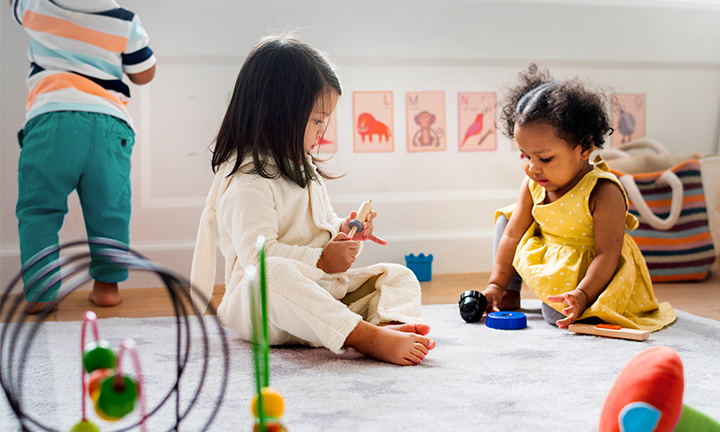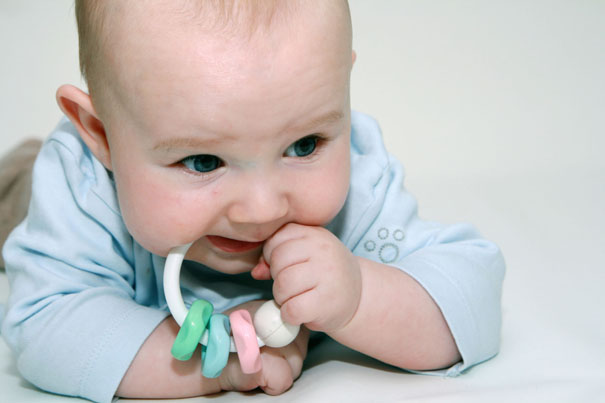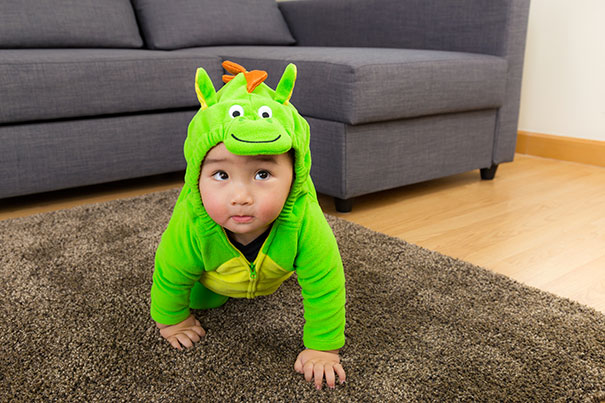- Baby
- Activities
- Engaging Indoor Activities for Babies, Toddlers, and Preschoolers

Engaging Indoor Activities for Babies, Toddlers, and Preschoolers
Looking for indoor activities for babies , toddlers, or preschoolers? We've collected lots of great ideas for you! Some of these are games you can do together, while others are activities your older baby or toddler might be able to do on their own with you nearby to supervise.
Being stuck inside doesn't have to be boring; with a little imagination, you and your little one can have lots of fun. Remember, you don't need to schedule activities to fill every moment, but it's helpful to have a few ideas up your sleeve for when you need them.
Activities to Do With Your Baby at Home
If you're working from home or need some indoor play inspiration, here are some indoor activities for infants you can do with your little one at home:
Make noise with random household objects. Grab some safe household items like an empty box, a wooden spoon, and a plastic lid, and let your baby pick which one they want to play with. Your baby will enjoy handling each item and banging it to see what noise it makes. Just make sure whatever you give them isn't breakable or dangerous.
Show your baby something magical. Another fun indoor activity you can do at home with your baby is to show them how certain things work. Seeing you press a switch that turns on a light or pressing a doorbell that makes a loud sound will be magical for your baby.
Look out the window. Hold your baby up to the window and point out birds, passing cars, a squirrel running along the fence, or the shape of clouds.
Have a dance party. Turn on some fun music and dance with your baby. Thisindoor baby activity is not only fun but also helps with your infant's development. If your baby is old enough to stand with your support, they'll love that you're dancing hand in hand.
Read together. It's great to start reading picture books to your little one at an early age. Point out the characters in the story and use expressive voices to bring the story to life. Get your baby involved by helping them hold the book and turn the pages.
Sing or chant nursery rhymes together. Those rhymes and songs that have simple hand movements will particularly delight your little one. You'll love seeing your baby squeal along even if they don't yet have the words or actions down pat. You may remember one or two from your childhood, but you can also check out these popular nursery rhymes.
Build an obstacle course. Your older baby or toddler loves to crawl, climb, and explore. This indoor activity for babies involves creating an obstacle course using pillows and boxes, and your little one will be thrilled at the challenge of getting over, under, and around the objects.
Create a mountain to climb. Pile up pillows and blankets to create a mountain in your living room, and then encourage your little one to climb over and around it as you stay close by. This is another fun indoor activity for babies that promotes physical development.
Create a bridge. Pull two chairs together with about a yard between the backs of the chairs. Place a towel or blanket over the top, encouraging your toddler to crawl under the bridge. They'll love the sense of achievement and finding you waiting on the other side.
Blow bubbles. Blow bubbles around your baby and watch them try to swat at them in wonder.
Play with blocks. Piling blocks into a tower that can later be knocked down is a big favorite among many older babies and toddlers. Traditional wooden blocks are nice, but you can also make your own box blocks by stuffing milk cartons, cereal boxes, or shoe boxes with paper and taping them shut. Playing with blocks is a classic indoor baby activity that aids in developing hand-eye coordination.
Roll balls back and forth. You can also name the features of the ball as you do it; for example, you could say "Roll the yellow ball to me! " Once your baby is older you can also play this with a few different balls and say things like "Roll the big striped ball."
Play peek-a-boo. Your baby will be delighted as you reveal your face from behind your hands or from behind a blanket or tower. You can pull a funny face to create even more laughter. Peek-a-boo is a simple yet engaging indoor activity for babies that helps with social development.
Assemble a tactile tub. Put clothes of different fabrics such as coarse wool, smooth silk, beaded materials, or netting in a tub, box, or bag. Let your baby handle and feel the different materials. A tactile tub is an excellent indoor activity for infants to explore different textures.
Organize a safe kitchen cupboard. Though you may have baby-proofed your low kitchen cupboards by locking them shut, you might like to keep one cupboard open to store safe, unbreakable items like small pots and tubs with lids and wooden utensils for your baby to play with and explore. They'll love the thrill of being able to grab, bang, and shake all the different objects. This is another fun indoor baby activity that promotes exploration.
Rotate toys. Your baby will be intrigued with something "new" if you rotate toys and keep the rest hidden. When you give them a toy, encourage them to crawl to reach it and let them figure it out themselves so that they get that sense of achievement.
For advice specific to your baby's age, check out our baby development milestones articles.
Fun Indoor Activities for Your Toddler at Home
Here are some fun activities you can do indoors with your toddler as well as solo play ideas you can encourage:
Sort objects. Put an array of safe objects on the floor and help your toddler learn how to sort them by color, size, shape, or type. Objects can include all kinds of household things like socks, a hat, a brush, a clean sponge, fruits, bottles, tubs, and boxes.
Make a shape box. Find a small ball and a block, and then cut a rectangle and a circle into the lid of an old shoe box, making the openings the same size as these objects. Help your toddler learn to place each item in the right hole. Explain the features of the shape by saying things like "See, this block has square edges. Which hole has square edges? " and watch them triumph when the object successfully falls through the hole.
Play hide and seek. As your toddler gets older, they will be up to the challenge of finding you hidden behind a sofa or behind a door. They will also love the thrill of hiding behind a curtain and waiting for you to find them.
Let your toddler help you with chores. Your little one wants to mimic you and may want to help out when they see you doing chores. Encourage their desire to be helpful by letting them participate in doing safe tasks. You could put on fun music and put their toys away together, or you could ask them to help you fold socks. Be encouraging and help them help you.
Cook together. Why not bake some cookies or cupcakes? If your toddler is old enough, let them help out with mixing the ingredients, pouring the batter into the pan, or frosting the finished product. Or they could just be there to help you as the chief taste tester. Just make sure that everything is safe: for example, don’t leave any sharp utensils within your child’s reach, and keep them away from the hot stove and oven.
Share family stories. Your toddler probably loves hearing about themselves and where they come from. Take out a photo album and show them pictures of yourself when you were younger as well as those of their grandparents. You could even show them pictures of themselves when they were a newborn. They will love learning about their family tree and hearing stories about themselves.
Create a scrapbook together. Gather some paintings or drawings your toddler has done and let them pick out some favorites. Get a big notebook or folder and add the art with the date alongside it. In a few years, your child will love having this special keepsake of their earliest work.
Display your child’s art. If your toddler is old enough, you can get them involved in choosing which of their artworks to display, and you can even select a wall that becomes your toddler's very own art gallery. If you don’t want to stick anything on the wall, simply hang it on the fridge using a magnet.
Write letters together. If you have an older toddler, why not encourage them to write a letter to their favorite grandparent? You can discuss what they'd like to write and you can help by writing the letter, and you can encourage them to scribble their name at the bottom as their "signature. " You can also show them how a letter is addressed and let them stick on the stamp. It’s OK if you can’t send it right now; put it aside and mail it when you have a moment. The recipient will be delighted!
Build a fort using a sheet. Your toddler will love this activity—you could even call it indoor camping! All you need is a few chairs with a sheet draped over the top to create the fort. Put a comfy pillow inside for your little one to sit on. Once the fort is made, encourage your toddler to look at their picture books in there or give them a flashlight they can use to make light shapes with. You might find they make it their own little domain that they can spend hours hiding out in. Over time, you'll find your toddler uses their creativity and imagination to make the fort into whatever they want it to be, whether it’s a spaceship, a pirate ship, or a castle. Watch this short video on the power of play with your toddler:
Chalk it up. Set up a blackboard and let your toddler draw with chalk. You might ask them to be the "weather person" each day and ask them to look outside and draw what they see—it could be sun, clouds, or rain, for example.
Dip into finger painting. Arts and crafts are a great indoor activity for toddlers. Grab some big sheets of paper and put out the paint, spreading a drop cloth or newspaper underneath to protect the table or floor. Let your toddler play with the paint and mix colors with their fingers to see how new colors can be formed this way. You could help your little one paint handprints, too. Paints that are suitable for children usually wash out of clothes fairly easily, but you may want to dress them in a smock or clothes you don't mind them getting dirty.
Squish colored spaghetti and rice. Cook up a small amount of spaghetti and rice and place a few spoonfuls in a few different bowls. Wait for it to cool and add some different colored food coloring to each bowl. Then, let your little one squish the foods with their hands and explore the different colors, textures, and sounds. They'll love making a mess with their hands and feeling the food squish between their fingers!
Sort some pom-poms. You might be able to get these budget-friendly round puffs in various colors at your local arts and crafts store or at an online retailer. Give your toddler a muffin tin and ask them to sort the pom-poms by color. Your toddler will like the challenge, the feel of the textures, and the look of the bright colors, and this task will help improve their hand and finger skills.
Create a stained-glass window. Get some colored tissue paper and let your toddler tear it into small shapes; then help them stick these onto a window to create their own stained-glass window. To stick them you can either use water or glue (just make sure it's the kind that will wash off easily afterward). A less messy approach may be to tape a big square of wax paper onto the window first, and then help your little one glue the shapes onto the wax paper. This idea will help them learn to fit shapes together and allow them to express their creativity. They'll also enjoy watching how the colors change depending on how the sun shines in.
Stomp on bubble wrap. If you have bubble wrap at home, place a large square on the floor and let your toddler jump on it to pop the bubbles.
Make a rainbow. Get your toddler to scrunch up colored tissue paper into tiny balls, and then help them stick them on a piece of paper to create a rainbow. If you have limited colors of paper, choose a motif to match. For example, if you have brown and green paper, help your toddler create a tree.
Do a puzzle. Help your older baby or toddler put the shapes of a large, simple puzzle in the right spot.
Create a sign for the fort. If your toddler is older, they may love the idea of having an entry sign for their fort. Use supplies like glitter and colorful pencils to make the sign and make it match whatever they imagine their fort to be. For example, it could say "Mia's Fairy Wonderland" or "Krystal's Castle."
Look in the mirror. Your toddler loves looking at themselves in the mirror and following your instructions. For example, ask: "Where's your nose? " or "Can you stick out your tongue? " You can even ask your toddler to look carefully at their eyes and tell you what color they are.
Impersonate an animal. Play a fun game with your toddler in which you pick an animal like an "eagle" and then soar through the sky (your living room) with your arms outstretched as if they were wings. Then say "giraffe" and encourage your toddler to stretch up nice and tall with their arms up high and their hand bent forward as the giraffe's head. You can become an elephant by holding one arm up to your nose like a floppy trunk. Another option is to jump around the house pretending to be kangaroos. What fun! Let your child show you how to imitate certain animals for extra fun, and encourage them to make the corresponding animal sounds, too.
Play ball. Your toddler will enjoy rolling a ball back and forth or playing catch with you, and these are good ways to improve their hand skills and hand-eye coordination. Just make sure you pack away any breakables like vases and photo frames because your toddler's aim will be off (whether it's accidental or on purpose!), and your aim might need some practice, too!
Ideas to Keep Your Preschooler Having Fun and Learning
Here are some great indoor boredom busters you can do with your preschooler. These engaging activities will help your 3-, 4-, or 5-year-old develop and grow in many ways, from improving hand and finger skills and expressing his creativity to learning about numbers, shapes, and letters.
Form geometric shapes. Show your little one how to draw shapes like stars, triangles, and diamonds on paper, and then let him decorate the shapes, too, with markers, glitter, paint, or whatever you have on hand.
Cut and paste paper. If you have child-safe scissors at home, your little one will enjoy cutting shapes from paper and gluing them onto another sheet to make a collage. Another idea involves your preschooler cutting a hairstyle for a toilet paper roll “troll.” To do this, take a clean toilet paper roll and draw a face on the lower half using a black marker. Then cut long strands of hair by cutting into the roll vertically. Once the troll is ready, let your preschooler cut the troll’s hair however he’d like to. Get ready for some crazy hairdos!
Play card and board games. A great family activity can be playing simple card or board games that are suitable for your preschooler’s age and attention span. Just keep in mind that your child may get upset if he doesn’t win every game.
Experiment with clay. Your preschooler will like making all kinds of shapes and balls with clay. One idea is to help him roll the clay into a large egg shape. Then let him make it into an “egg head” by adding colorful feathers as the hair, fake eyes or beans as the eyes, pipe cleaners as the mouth and ears, and a pom-pom as the nose.
Draw and paint. Your child can have fun creating art with crayons, markers, or pencils. Or have him do some finger painting or painting with a brush (or other painting tools). Select a few artworks to put into a memory book, or display some on a wall or on the fridge.
Make paper plate faces. If you have some paper plates at home, get out some arts and crafts supplies and let your preschooler decorate the plate. Let him use his imagination to add eyes, a nose, a mouth, rosy cheeks, and hair.
Explore books that introduce concepts. As you pick out some books to read together, include some that cover concepts such as the days of the week, the seasons, size (e.g., big versus small), the alphabet, counting, and the names of geometric shapes, for example. The focus shouldn’t be on pressuring your preschooler to learn; rather, the books should be so engaging that your little one is interested in finding out more.
Answer the “big” questions. If you find your little one asking questions like “Why is the sky blue?” or “Where does the sun go at night?” don’t feel you have to have all the answers at the ready. Instead, see if you can look for the answers together using books that you have or online resources for children. Often these important questions are answered in a way that’s easy for young people to understand. Doing this will show your child that it’s OK not to know something, and that it’s great to search until you find the answers.
Take a virtual tour. If you’re stuck indoors, you may be able to take your child on a virtual tour of a zoo or a museum. This can help your little one explore places and learn about things that interest him in an interactive way. With all of the free online resources available now, you don’t have to leave your home to see fascinating things from all over the world.
Discover what sinks and what floats. Encourage your young scientist to explore the concept of buoyancy by inviting him to sail different objects across a miniature pond. Fill a dishpan half full of water and collect some objects of different densities: small pieces of cork, wood, paper, and plastic, along with a leaf, a stone, a bar of soap, and a sponge. Have him experiment with the objects to see which ones sink and which ones float. You could even ask him to guess first and then test his prediction.
Go on a treasure hunt. Create a basic map of your living room complete with the TV, windows, sofa, and rug marked using matching colors and clear drawings. Then draw an X to mark a few spots where you’ve hidden a surprise. The treat could be something like a single piece of candy or a sticker. You might like to hide something under a pillow or leave one on a ledge behind the curtain. Your preschooler will love the hunt as well as the thrill of finding his treasure. (Just make sure your living room is baby-proofed before getting started, so that your little one is nice and safe.)
Make an indoor garden. Gather some pots, potting soil, and some seeds or seedlings. Then show your preschooler how to plant seeds and water his plants. Watching it grow together will be a satisfying joint project that you’ll both enjoy.
Frost some cupcakes. If you enjoy baking, this is a nice way to spend time with your preschooler in the kitchen. Bake some cupcakes together and let your preschooler help you decorate them after they've cooled down. You can top them with moss green or purple colored frosting and ask your toddler to sprinkle them with edible glitter to make them into “fairy cupcakes.” Alternatively, if a special day like Halloween is coming up, go with orange-colored frosting, and help your preschooler use licorice or black candy to create spiders as the decoration.
Track your preschooler’s height. As your little one grows taller, it’s fun to mark his height on a wall or door frame. Of course, you can always buy a height chart or create your own poster using large sheets of paper and a ruler. Your preschooler will love seeing how tall he is, and seeing how much he’s grown since the last measurement.
Send and receive mail. All children love getting mail, so ask a close friend, grandparent, or other relative to write to your preschooler via email. Your little one will be delighted to get a message sent to your email address that’s just for him. If one of your close relatives has a birthday coming up, get your little one to design a birthday card (the card can always be mailed later) and then give the lucky person a video call so you and your preschooler can sing "Happy Birthday."
DIY learning folder. Your older preschooler may enjoy learning in a more formal way, especially if he’s started preschool or will begin soon. Get a binder with at least 3 rings, a few sheets of 8.5" by 11" paper, and a plastic sleeve for each sheet. Each sheet should be dedicated to a specific topic, which could include the alphabet, geometric shapes, colors, days of the week, numbers 1 to 10, and seasons. You can design these sheets on your computer, making sure that the letters, shapes, or numbers are nice and big on each sheet. Then you’ll need to create cut-outs to match. So, for the seasons, you could make a cut-out of a sun, snowflake, fall leaf, and flower. Then stick a little adhesive putty on the back of each shape, and have your child place the symbol on the correct part of the page. Your preschooler may need help completing the various activities but if you help him and make it enjoyable, he’ll learn in time.
To help you feel more connected to other parents like you, it might help to create or join an online chat group or forum for other parents in your community where you can share creative ideas for fun indoor activities.
You’ll be able to share tips and encourage each other. Plus, if one of you is having a bad day or struggling with a specific challenge, you can be there for each other. Even though you’re at home with your little one, being in touch with fellow parents via phone, video chat, or group chat will help you feel that you’re not actually alone.
Listed in this article are just some of the many fun activities you and your child can do at home, with a number of them not requiring anything other than everyday household objects and a little imagination. Your little one learns through play, and while these activities help your child’s development, you might find that you enjoy these shared moments, too!
If you happen to be working from home, read our article on how to stay productive while caring for a baby or toddler.
Read more about Baby
Related Articles
Join a World of Support
through Pregnancy and Parenthood.
![toy]()
TRACK WITH TOOLS
![baby]()
LEARN WITH EXPERTS
![Gift]()
GET REWARDED

Where You Already Belong












